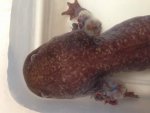Quentari
New member
- Joined
- Feb 7, 2013
- Messages
- 567
- Reaction score
- 5
- Points
- 0
- Location
- Melbourne
- Country
- Australia
- Display Name
- Quentari
I have a copper axolotl named pebble. Literally overnight he got a terrible fungus on his gills. I went to bed, we was fine. Went to feed him the next evening, his gills were like this. I've been giving him salt baths twice a day for the last three days plus keeping him fridged but the fungus isn't getting any better.
I've been using regular salt, would aquarium salt work better? Should I try a higher concentration of salt? I haven't had an axie live through a fungus yet, the fridge is like a death sentence and I'm really worried he won't be okay. His tail is hooked so I know he's uncomfortable/in pain, and there's little bright red blotches in his gill fronds, I'm thinking its blood.
I've tried gently trying to remove the fungus but its really stuck in there, more like mould really.
He's totally lethargic. Only moves while he's in his salt bath, otherwise he's totally still. I keep thinking he's dead!
Has anyone got any advice?
I've been using regular salt, would aquarium salt work better? Should I try a higher concentration of salt? I haven't had an axie live through a fungus yet, the fridge is like a death sentence and I'm really worried he won't be okay. His tail is hooked so I know he's uncomfortable/in pain, and there's little bright red blotches in his gill fronds, I'm thinking its blood.
I've tried gently trying to remove the fungus but its really stuck in there, more like mould really.
He's totally lethargic. Only moves while he's in his salt bath, otherwise he's totally still. I keep thinking he's dead!
Has anyone got any advice?

